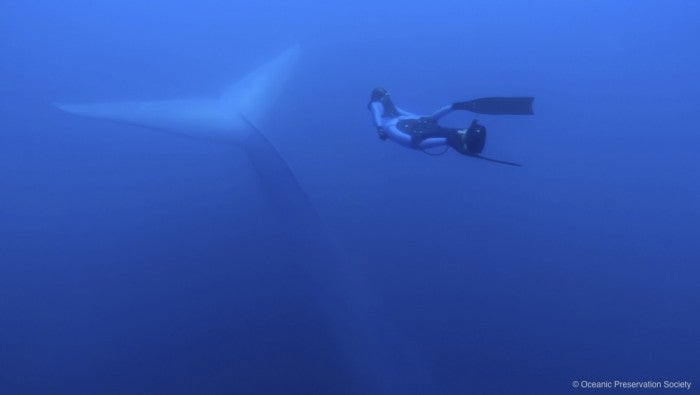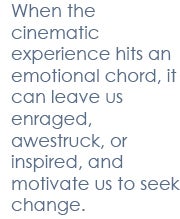
(Photo Credit: “Racing Extinction”)
Hilary Sparrow is a senior supervising producer at Vulcan Productions, where she develops and produces feature films, television series, specials, and digital content designed to inspire people to take action on critical issues. We caught up with Sparrow, an upcoming presenter at the Aspen Ideas Festival, to learn more about how she uses film to incite change.
She’ll be speaking at the Festival on July 1st after a screening of the latest film she’s working on, “Racing Extinction,” which will be released this fall (watch the trailer here).
They say an elephant never forgets and I’ve seen it first-hand. I was 24 years old, on a shoot for National Geographic Television in Shreveport, Louisiana, a small Southern town still clinging to the past. At the Shreveport Zoo, I met a crippled former circus elephant, Shirley, who had lived alone for over 20 years. Elephants are a matriarchal species with a tight family hierarchy and close bonds. For Shirley, living without any other elephants would be like any of us living in solitary confinement. Except she wasn’t entirely alone. She had Solomon, a zoo keeper with no formal training, but a deep bond with Shirley. Each day he cared for her, loved her, and did his best to make up for her loss of an elephant family. She was kept on chains in Shreveport and Solomon would bath and feed her daily.

After 22 years of solitary living, we filmed her transport to The Elephant Sanctuary in Hohenwald, Tennessee, the nation’s largest natural habitat refuge for elephants. Solomon made the journey with her. The cameras followed as he unloaded her and helped her get settled into her new home. And as he was saying his goodbyes, unprompted, he turned to the camera and said, “When I saw this place, I told her there’d be no more chains. She’s free now… I don’t know who is the first to put a chain on her, but I’m glad to know I’m the last to take it off. She’s free at last.”
To this day, thinking about that moment sends chills down my spine. Solomon was crying, the entire film crew was crying, and I knew we had given audiences an emotional connection to Solomon and to elephants that they would have never experienced through a lifetime of visiting zoos.
The experience didn’t end with Solomon’s goodbye. A few hours later, Shirley recognized Jenny, a fellow elephant she had known over 24 years ago in the circus. Shirley and Jenny trumpeted and rumbled at each other for hours, their trunks tangled, weaving around one another. Years later, someone posted the video of Shirley’s transport and reunion on YouTube. It’s been viewed nearly 10 million times, it’s helped the Sanctuary raise hundreds of thousands of dollars, and it provided millions of people with a deeper understanding of the complex nature of elephants. The film, “The Urban Elephant,” directed by Allison Argo, won two Emmy Awards.
These days, I begin thinking about the impact a film will have often before we even begin shooting it. At Vulcan Productions, the media company owned by philanthropist and Microsoft Co-Founder Paul G. Allen, we see film as a vehicle for change. The best films tell the most powerful stories. These stories transport us to places and situations we otherwise may never experience. They explain complex issues in a way that helps audiences deepen their knowledge. When the cinematic experience hits an emotional chord, it can leave us enraged, awestruck, or inspired, and motivate us to seek change.
A few years ago, Allen came to us with a desire to make an impact on the climate crisis. We knew we needed a strategically crafted campaign around a stunning and moving film that tapped into the emotional human connection to nature, much like Shirley did, in order to spark impact. Vulcan Productions found the perfect partner to achieve this perfect storm with Academy-Award winning Director Louie Psihoyos and his latest film, “Racing Extinction.”
The Earth is losing species at an alarming rate. Scientists predict that we may lose half of all species in the next 50 years. This mass extinction is powered by over-consumption of species and climate change.
Climate change is driving ocean acidification. It’s a wickedly complex web driven by a multitude of factors, and with over seven billion people on the planet, it’s easy to become overwhelmed and feel hopeless. But the power of “Racing Extinction” is that it fires audiences up. When they see the film, they immediately connect to the story of extinction and the beautiful images, which serve as a weapon for change. They become inspired to make a difference, and to have an impact on the health and future of our oceans and species.
When “Racing Extinction” is launched in the fall, we plan to use it as a powerful communications tool to drive concrete impact in the realms of policy, human behavior, and media and public information.
In my work, we are not just looking to tell stories of critical issues through film. We implement direct action that chips away at the problem through grassroots efforts, policy engagement, and mass media. When we get these elements activated and working in sync, feeding each other, we have the elements to create real, sustainable change. As the fall approaches and our work intensifies, I’m looking forward to being a part of a vast movement of people, scientists, environmentalists, and movie audiences who are inspired by “Racing Extinction” to be the change we want to see.
We are beginning to build the movement now. Won’t you join us?

